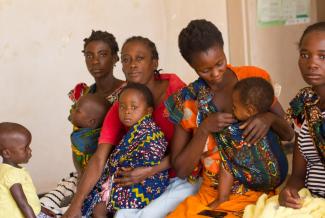IMPROVING THE HEALTH STATUS OF MALAWIANS IN TARGETED DISTRICTS
Over the last two decades, Malawi has achieved dramatic gains in most health indicators by focusing on the improved delivery of essential health services. Malawi is one of a few sub-Saharan African countries that achieved Millennium Development Goal (MDG) 4 for child survival by 2015. The Government of Malawi (GoM) reduced maternal mortality by 53 percent between 1990 and 2013, and increased the contraceptive prevalence rate from 7.4 in 1992 to 42 percent in 2010. With U.S. support, Malawi has reduced the number of HIV/AIDS deaths by 73 percent, and the number of new HIV infections by 41 percent since 2003.
These broad gains, however, mask important realities and structural dynamics in Malawi’s health system that must be addressed if the advances of the past two decades are to continue. With a total fertility rate of 4.4 contributing to explosive population growth, Malawi’s population is likely to more than double by 2050. Such growth has the potential to derail many development gains achieved to date.
Malawi has a high unmet need for family planning services (26 percent), with acute needs among young people. Close to one million people in the country live with HIV, with approximately 34,000 new infections each year. Even with the gains in child health, 37 percent of Malawian children suffer from chronic malnutrition. Malawi is a high-burden malaria country with an incidence rate of 332 cases annually per every 1,000 people and approximately 4.8 million episodes of malaria per year. Over a third of established positions in the health sector are vacant and there is a perpetual shortage of qualified health workers in facilities across the country. Such tremendous health challenges combined with constrained economic resources, and marginalized women and youth place a significant burden on the health system.
HIV/AIDS: USAID continues to invest in high-impact HIV prevention, treatment, and care activities with the goal of controlling the HIV epidemic. In coordination with the President’s Emergency Plan for AIDS Relief (PEPFAR) resources, USAID’s HIV investments mitigate the social and economic impact of the disease, especially among orphans and vulnerable children.
MATERNAL, NEONATAL, AND CHILD HEALTH (MNCH): USAID invests in quality of care interventions to sustain gains in maternal and child health and interventions designed to accelerate progress in neonatal health.
FAMILY PLANNING AND REPRODUCTIVE HEALTH: USAID works with Malawi’s Ministry of Health (MoH) to encourage comprehensive and efficient programming of resources that expand voluntary contraceptive options and provide high-quality, sustainable family planning and reproductive health services.
NUTRITION: USAID invests in nutrition activities for women and children, with a focus on the first 1,000 days from conception to age two. USAID’s programs focus on preventing chronic undernutrition by providing nutrition-related assistance through various implementing partners. Both USAID and the GOM fight stunting and other forms of malnutrition through lasting community empowerment and integration of health services.
TUBERCULOSIS (TB): USAID support the National Tuberculosis Control Program (NTCP) vision of a tuberculosis-free Malawi and actively works to reduce the morbidity, mortality, and transmission of TB until the disease is no longer a public health problem.
HEALTH SYSTEMS STRENGTHENING: USAID promotes health systems strengthening by supporting national efforts to decentralize health services and help the GoM maintain an uninterrupted supply of health commodities in the country’s communities and public health facilities.
WATER SANITATION AND HYGIENE (WASH): USAID works closely with the MoH and Ministry of Agriculture, Irrigation, and Water Development to improve access to and provision of quality WASH services.
PRESIDENTIAL MALARIA INITIATIVE (PMI): With support from USAID, PMI, and other partners, the Malawian Ministry of Health’s National Malaria Control Program (NMCP) has been able to scale up the distribution of artemisinin-based combination therapies (ACTs), intermittent preventive treatment for pregnant women (IPTp) using sulfadoxine-pyrimethamine (SP), and insecticide-treated nets (ITNs). In addition to these efforts, USAID works with the Malawian NMCP to procure and distribute Rapid Diagnostic Tests (RDT) and to provide critical training to health workers on Artemisinin-based Combination Therapy, malaria diagnosis, and ITN use.
PRESIDENT’S EMERGENCY PLAN FOR AIDS RELIEF (PEPFAR): The U.S. government, through PEPFAR, is proud to partner with the people and Government of Malawi in accelerating Malawi's progress toward achieving HIV/AIDS epidemic control. In Fiscal Year 2018, with a focus on 10 high-burden districts in Malawi to maximize impact.

